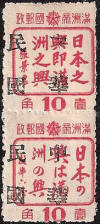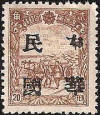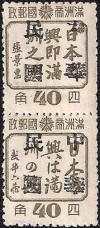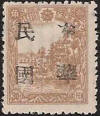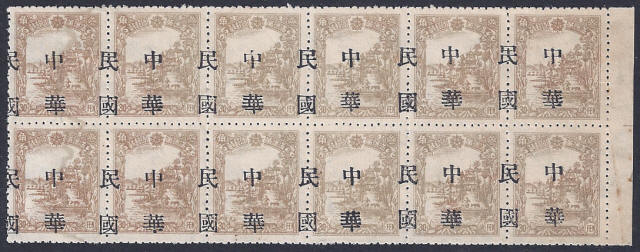 |
||||||||
|
|
Manchurian Local Overprints 1945 - 1947 |
|||||||
| Japanese | Kerr 28. |
|
Other Names | |||||
| 1932-42 Kinken | Chin Hsien | Jinzhou | Hái xiàn |
Chinchowfu |
||||
| from 1942 Kinshū | 頦 縣 |
(SMRZ) |
Chin Chow |
Jin Jou |
||||
| Chin-hsien |
Jinxian |
|||||||
| Map of 1945 | Chinhsien (Map) |
Jinjou |
||||||
|
徒河 Tuhe (historical name) |
||||||||
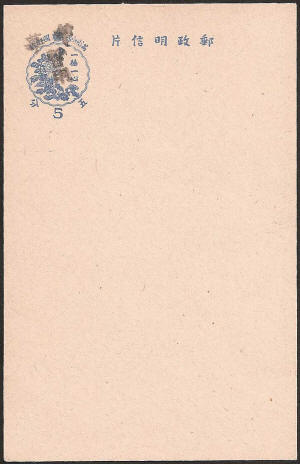
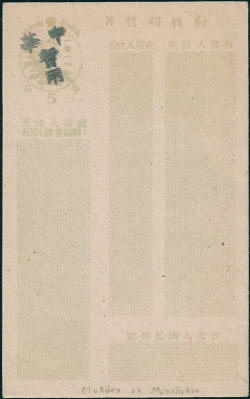 |
||||||||
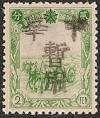 |
 |
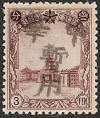 |
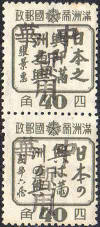 |
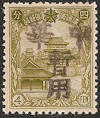 |
||||
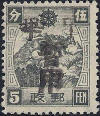 |
20f |
 |
||||||
| Not regularly issued (Kerr) | Not regularly issued | |||||||
|
First Overprints (Nationalist) 1st
September 1945 - This rubber hand-stamp was made locally under
instruction from the main Post Office in Changchun and produces the soft black
Mukden Type
overprints found on 10 stamps plus two types of imprinted postcard.
Kerr notes that the 5f was not regularly issued although this seems odd as 5c was the postcard rate at this time (confirmed by the examples above). It seems more likely that the 20f stamp was in short supply as it is missing from most albums I have seen. Other values are possible as stock was overprinted as it was sold. |
||||||||
|
|
||||||||
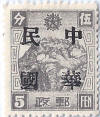 |
 |
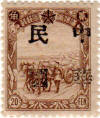 |
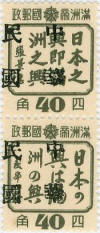 |
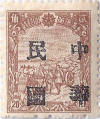 |
||||
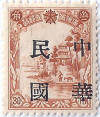
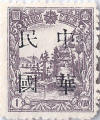 |
||||||||
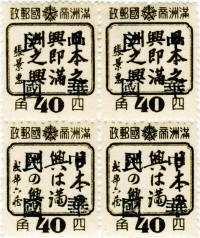 |
||||||||
|
Rounded Corner Variety (top left). Image supplied by Steve Jensen |
||||||||
|
Second Overprint - First
Setting (above) - Issued 29th November 1945
(Nationalist Issue) Printed by the San Yao Printing Press. This
is a machine printed issue made using No.3 Sung Type.
The overprint consists of four hard black characters reading
中華民國
Chinese Republic.
These characters are set evenly spaced in a square.
Second Overprint - Second Setting (below) - Issued 1st March 1946 (Nationalist Issue) Printed by the San Yao Printing Press. There is much confusion about this issue and each authority has a different idea about these stamps. Kerr - describes the second setting as soft black with the full set shown for the first setting being available in the second. Chan - suggests that the difference to look for is the long bottom petal in the 華 Hwa character, see below, again with all values in the first set being available Chiu - Again focuses on the 華 Hwa character and states that both are mixed on each sheet. He goes on to say that on the 5f stamps the top three rows of stamps have a blue black overprint while the other seven rows are black (due to poor mixing of the ink). So who is right? Kerr is right that some impressions are harder and some softer, but as the overprints are all typeset this does not necessarily constitute a different printing. Chan is right that the long petal Hwa is probably unique to the second printing, but I have shown it occurs alongside the normal Hwa so it is not a foolproof identifier. Chiu states that the long petal Hwa only appears on the 5f, 20f (1936) and 20f (1944) scenery issues but not the others. Probably therefore the most helpful information comes from Chiu, the sets exist but both Kerr and Chan's identification techniques are, in my view, unreliable. |
||||||||
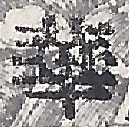 |
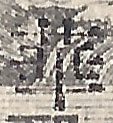 |
|||||||
| First setting short bottom stroke only | Second setting Long bottom stroke | |||||||
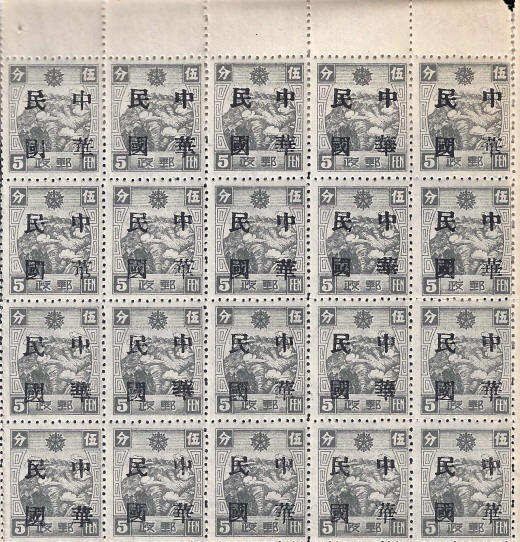 |
||||||||
| 5f Second Setting - Part sheet showing mixed settings. | ||||||||
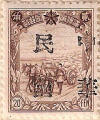 |
||||||||
| Long petal 華 Hwa | Long petal 華 Hwa | |||||||
|
Varieties |
||||||||
| A variety that does not seem to appear in Kerr or Chan, note the sloping top left character 民 and the broken top right character 中. | ||||||||
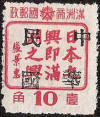 |
||||||||
| This is another distinctive variety where the 中 character does not line up vertically and is offset to the right - stamp #3 first setting only. | ||||||||
|
30f with overprint misplaced horizontally. |
||||||||
 |
||||||||
| 20f with the long petal 華 Hwa with the overprint inverted. | ||||||||
|
|
||||||||
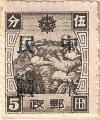 |
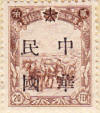 |
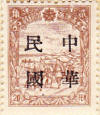 |
||||||
| Date and Printers Unknown - Very similar to the first two sets but with smaller hard black characters "Republic of China". | ||||||||
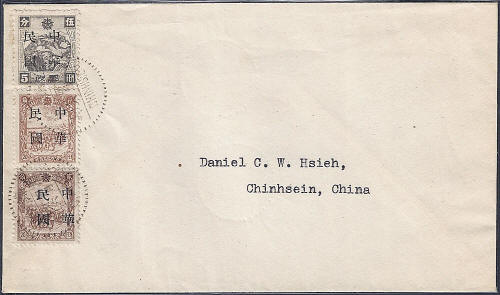 |
||||||||
|
|
||||||||
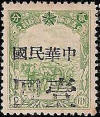 |
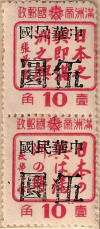 |
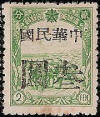 |
||||||
| 1Y on 2f | 3Y on 2f | |||||||
| 5Y on 10f | ||||||||
|
Issued 20th December 1945 In Chiu's Supplement it states that this set was needed because of a shortage of the 1Y stamp (another indication it would not have been available for the second setting of the previous overprint). In January 1946 the 5Y stamps were added because of a need by the army to send mail South by airmail, this cost 5Y. However, the sentiments expressed in the 10f stamps caused offence and under instruction by the main Post Office in Changchun these stamps were quickly withdrawn from sale. Registered airmail cost an extra 3Y, which explains the need for the 3Y surcharge. Although printed in Chin Hsien this set was widely distributed and used in many towns. I have seen it listed under Sui Chung in early collections and it also appears in Kerr under Liao Yang. Chiu mentions that sets of these stamps were also sent to Jehol. |
||||||||
|
|
||||||||
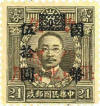 |
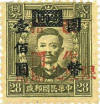 |
 |
||||||
| 5Y on $50 | 10Y on $100 | 20Y on $200 | ||||||
|
Issued August 1946 This set is shown by Kerr but not included by Chan and is possibly a little out of place in this context. The first two stamps are from the Hong Kong Martyrs (un-watermarked), Shanghai Union CNC Surcharge issue and the last is a 1944 postal savings stamp, they were clearly needed as a result on inflation. All were issued without gum. The surcharge is machine printed in Sung 5 type in red the bottom line reads "Limited for use in the North East" . These stamps also appeared in Shenyang and Hulutao. Forgeries exist and they can sometimes be found cancelled to order for dealers. Note: A similar surcharge in black was prepared but not issued in 1948, this was applied to parcel post stamps. The surcharges were for $50, $100 and $300, these are extremely rare. |
||||||||
|
|
||||||||
These stamps have been identified by using Volume II of the Stamp Catalogue of China by Shui-Hon Chan and the four booklet guide The Local Overprinted Stamps of Manchuria 1945-7 by Allen D Kerr (published 1978 and now out of print). Both works are essential for anyone delving seriously into this subject. Much of the detail above comes from Chiu's Supplements. |
||||||||
| D21, D23, D255 | ||||||||
